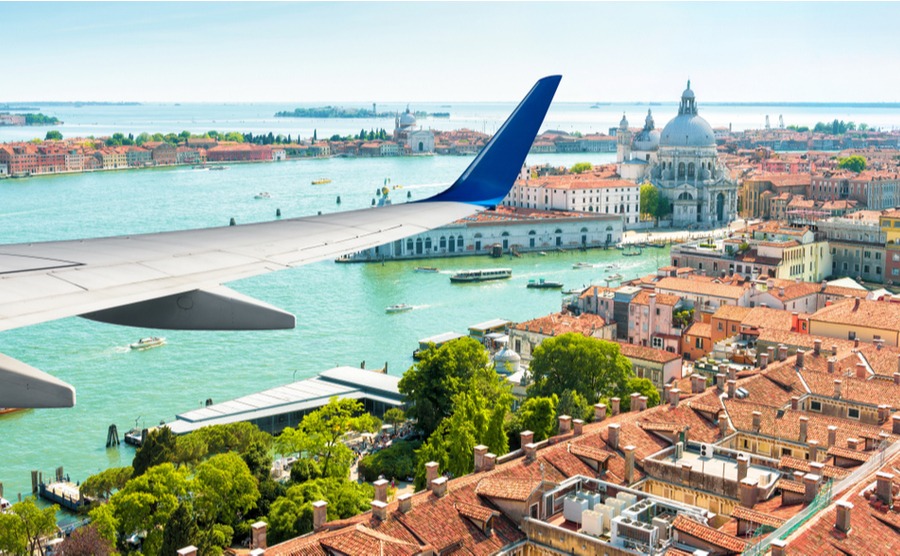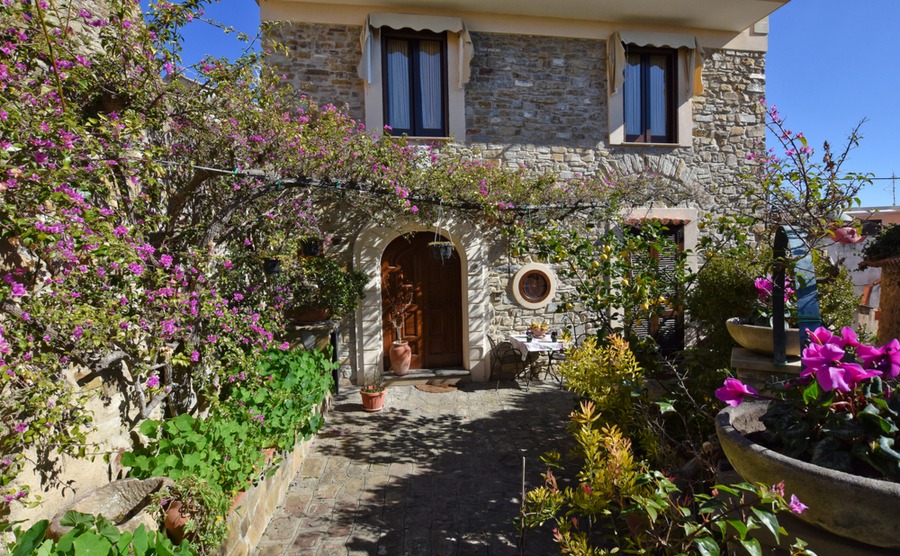Buying property in Italy is easy and safe, with no quarantine or need to self-isolate on your return. That’s if you want to return anyway. With only four months until the Brexit transition period ends, this could be your best chance to gain residency in Itay with all your EU rights intact. But can you fly there?
You are welcome to travel to Italy from the UK for any reason including a holiday, viewing trip or to move home. Italy is currently on the list of countries exempt from the UK Foreign Office advise against all but essential international travel. This travel advice is being kept under constant review. Check the UK Government’s website before you travel, for updated information.

Arriving in Venice
Will I need to self-isolate?
You are not required to self-isolate on arrival in Italy from the UK, or on return (at time of writing). To check the conditions of entry from a full list of countries visit the Italian Ministry of foreign affairs website.
Is the government likely to impose self-isolating?
The British government imposes quarantine on countries where the number of new Covid cases per 100,000, in the previous seven days, exceeds 20.
In the week to 1 September, Italy is on 15 and the UK on 14. For comparison, Spain has 122 and France 54. Switzerland’s cases have reached 25 per 100,000 in the last 7 days and visitors arriving from there now need to quarantine on arrival in the UK, while Portugal, currently on 22, may have quarantine re-imposed from next week.
It is very difficult to predict if cases will rise further in Italy to the point where quarantine is imposed. However, cases are not rising especially fast in Italy right now, and death rates are firmly below 10 per day, fewer than in the UK.
Italy is to be starting to go down the route of testing at airports rather than forcing people to self-isolate for two weeks.
Will I be tested in Italy?
Arrivals from the UK are currently not being tested, but will have their temperature checked. If you have stayed in or transited through Croatia, Greece, Malta or Spain in the last 14 days you will have to produce a negative coronavirus test, done within the past 72 hours, or be tested on arrival. These travelers are required to self-isolate until they have received a negative result. Other countries could be added to this list if considered at risk areas. Testing at airports seems to be the direction Italy is taking.
Since Mid-August Italian airports have been taking steps to equip themselves to offer testing services. Airports at Rome Fiumicino and Ciampino quickly set up testing centres on site. At Milan Malpensa it is possible to have a swab test and Venice does quick tests. At some airports you are required to book your test in advance and at others you are directed to the nearest drive through testing point. In Puglia you must stay in isolation for 72 hours before being tested.
Are flights still going?
There are plenty of flights to Italy. Most regions having their own airport, so there is no need to travel via the capital city. Ryanair fly London Stansted to 22 Italian airports. A search on their website on the 31st August revealed return flights at the end of September to Perugia, Umbria from £44. Brindisi, Puglia from £48 and Palermo, Sicily from £30.
Are any forms required?
Both Italy and the UK require you to fill out a form before entering the country. This is so that they can trace you quickly if you have been in contact with someone who has developed coronavirus. Before your journey you must fill in the Italian form. In addition, Sardinia , Sicily , Puglia and Calabria each have their own forms. If you want to return to the UK, you are required to submit an online UK form 48 hours before you enter the country.
Can I view and purchase a property?
You can view properties in Italy, while social distancing, wearing masks and sanitizing your hands regularly. Estate agents, property lawyers and notaries are open and ready to assist you every step of the way. Finding a good estate agent to guide you through the process is invaluable. Property Guides can help by putting you in contact with trusted estate agents and property lawyers.

Your home in Italy? (Giambattista Lazazzera / Shutterstock.com)
New cases – How does Italy compare?
On 31st August, 996 new cases were recorded in Italy, compared to 1,406 in the UK, 3,082 in France, 2,489 in Spain and 1,408 in Germany. There was a rise in cases in Italy during the last week of August, but over the summer they have been lower than France, Spain and the UK. This is partly why you are not required to self-isolate when returning from Italy.
Many of Italy’s new cases were young people returning from holidays in Spain, Greece, Croatia and Malta, and attending private parties. This was recognized very quickly, hence it was made mandatory to have a swab test when returning from these countries. As a result new cases were diagnosed quickly, even when asymptomatic. There have also been resent cases in people returning from holidays in Sardinia.
Where are the most recent outbreaks?
Recent clusters have been in Sardinia, and the small hamlet of Casamaina, in Abruzzo. The Lombardy region continues to have the highest new daily cases, followed by Campania, Lazio, Veneto and Emilia Romagna. Where clusters are discovered they are immediately self-isolating. Contacts are also traced and self-isolate.
Which regions have the lowest number of cases?
The more rural and mountainous regions are currently recording the lowest number of active cases. These are Valle d’Aosta, Molise, Basilicata, Calabria, Trento Alto Adige and Marche. Recent data shows that Sicily, Puglia, Campania, Lazio and Umbria, have also recorded less than 0.20% contagion rate of population.
Are face masks compulsory?
Wearing a face mask in enclosed public spaces in Italy, including shops and public transport, remains compulsory throughout the country. The Italian Government started to take new restrictive measures in mid-August, making it also mandatory to wear face masks from 6pm until 6am even in outdoor areas of restaurants, bars and places open to the public. Generally, you will see Italians wearing masks most of the time, especially in areas where social distancing is difficult, such as busy streets and markets.
1 euro homes
After the success of selling 1 euro homes in Sambuca, Sicily, there is talk of releasing further homes in the village for 2 euros. The village of Cinquefrondi in Calabria has also been offering small abandoned properties for 1 euro. If you want to be in a bustling town take a look at the city of Taranto in Puglia. They are beginning to release some larger buildings in the historic centre for 1 euro.
With all these 1 euro offers, there will be some conditions to meet. Such as, a €5,000 deposit and making a commitment to complete the renovation within 3 years. Many people end up looking at other homes in the area that need less work, but are still reasonably priced. There are still many cheap countryside and village homes dotted across Italy.









